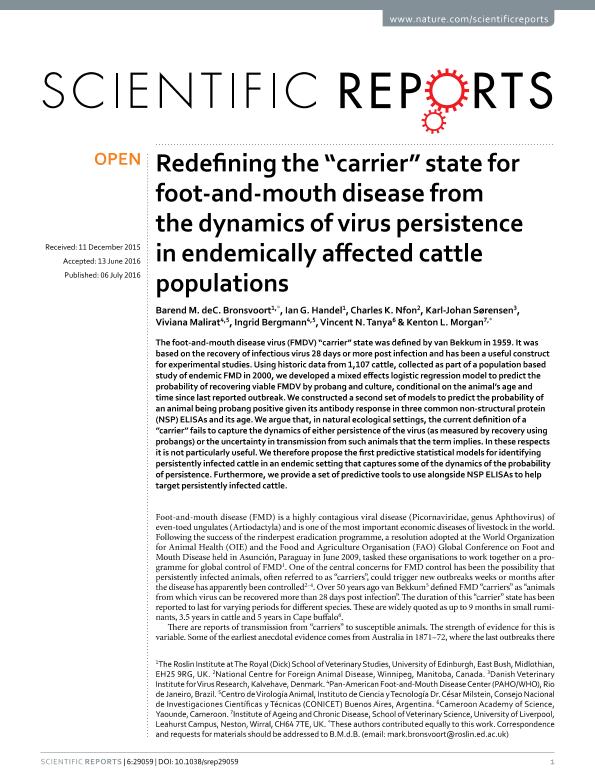Mostrar el registro sencillo del ítem
dc.contributor.author
Bronsvoort, Barend M. de C.
dc.contributor.author
Handel, Ian G.
dc.contributor.author
Nfon, Charles K.
dc.contributor.author
Sorensen, Karl Johan
dc.contributor.author
Malirat, Viviana

dc.contributor.author
Bergmann, Ingrid Evelyn

dc.contributor.author
Tanya, Vincent N.
dc.contributor.author
Morgan, Kenton L.
dc.date.available
2018-03-28T14:05:58Z
dc.date.issued
2016-07
dc.identifier.citation
Bronsvoort, Barend M. de C.; Handel, Ian G.; Nfon, Charles K.; Sorensen, Karl Johan; Malirat, Viviana; et al.; Redefining the "carrier" state for foot-and-mouth disease from the dynamics of virus persistence in endemically affected cattle populations; Nature Publishing Group; Scientific Reports; 6; 7-2016; 1-10
dc.identifier.issn
2045-2322
dc.identifier.uri
http://hdl.handle.net/11336/40347
dc.description.abstract
The foot-and-mouth disease virus (FMDV) "carrier" state was defined by van Bekkum in 1959. It was based on the recovery of infectious virus 28 days or more post infection and has been a useful construct for experimental studies. Using historic data from 1,107 cattle, collected as part of a population based study of endemic FMD in 2000, we developed a mixed effects logistic regression model to predict the probability of recovering viable FMDV by probang and culture, conditional on the animal's age and time since last reported outbreak. We constructed a second set of models to predict the probability of an animal being probang positive given its antibody response in three common non-structural protein (NSP) ELISAs and its age. We argue that, in natural ecological settings, the current definition of a "carrier" fails to capture the dynamics of either persistence of the virus (as measured by recovery using probangs) or the uncertainty in transmission from such animals that the term implies. In these respects it is not particularly useful. We therefore propose the first predictive statistical models for identifying persistently infected cattle in an endemic setting that captures some of the dynamics of the probability of persistence. Furthermore, we provide a set of predictive tools to use alongside NSP ELISAs to help target persistently infected cattle.
dc.format
application/pdf
dc.language.iso
eng
dc.publisher
Nature Publishing Group

dc.rights
info:eu-repo/semantics/openAccess
dc.rights.uri
https://creativecommons.org/licenses/by-nc-sa/2.5/ar/
dc.subject
Virus de La Fiebre Aftosa
dc.subject
Portador
dc.subject
Serologia
dc.subject.classification
Virología

dc.subject.classification
Ciencias Biológicas

dc.subject.classification
CIENCIAS NATURALES Y EXACTAS

dc.title
Redefining the "carrier" state for foot-and-mouth disease from the dynamics of virus persistence in endemically affected cattle populations
dc.type
info:eu-repo/semantics/article
dc.type
info:ar-repo/semantics/artículo
dc.type
info:eu-repo/semantics/publishedVersion
dc.date.updated
2018-03-27T14:48:47Z
dc.journal.volume
6
dc.journal.pagination
1-10
dc.journal.pais
Estados Unidos

dc.description.fil
Fil: Bronsvoort, Barend M. de C.. University of Edinburgh; Reino Unido
dc.description.fil
Fil: Handel, Ian G.. University of Edinburgh; Reino Unido
dc.description.fil
Fil: Nfon, Charles K.. National Centre for Foreign Animal Disease; Canadá
dc.description.fil
Fil: Sorensen, Karl Johan. Danish Veterinary Institute for Virus Research; Argentina
dc.description.fil
Fil: Malirat, Viviana. Consejo Nacional de Investigaciones Científicas y Técnicas. Oficina de Coordinación Administrativa Parque Centenario. Instituto de Ciencia y Tecnología "Dr. César Milstein". Fundación Pablo Cassará. Instituto de Ciencia y Tecnología ; Argentina
dc.description.fil
Fil: Bergmann, Ingrid Evelyn. Consejo Nacional de Investigaciones Científicas y Técnicas. Oficina de Coordinación Administrativa Parque Centenario. Instituto de Ciencia y Tecnología "Dr. César Milstein". Fundación Pablo Cassará. Instituto de Ciencia y Tecnología ; Argentina
dc.description.fil
Fil: Tanya, Vincent N.. Cameroon Academy of Science; Camerún
dc.description.fil
Fil: Morgan, Kenton L.. University of Liverpool; Reino Unido
dc.journal.title
Scientific Reports
dc.relation.alternativeid
info:eu-repo/semantics/altIdentifier/doi/http://dx.doi.org/10.1038/srep29059
dc.relation.alternativeid
info:eu-repo/semantics/altIdentifier/url/https://www.nature.com/articles/srep29059
Archivos asociados
